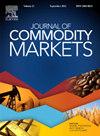Energy price uncertainty and sectoral tail risk: Evidence from quantile-on-quantile connectedness
IF 4.5
4区 经济学
Q1 BUSINESS, FINANCE
引用次数: 0
Abstract
As the Chinese market increasingly becomes dependent on uncertainties in coal and oil prices, this paper examines the implications for financial markets and the transmission of tail risk across various industries. Employing a generalized quantile connectedness network model, we analyze the impact of coal price uncertainty (CPU) and international oil price uncertainty (OPU) on the volatility of Chinese sectoral stock markets during the period from 2016 to 2025. The study yields the following key conclusions: (1) In the context of “directly related” tail states, systemic risk spillover is most pronounced; (2) The net risk spillover from CPU and OPU primarily occurs under conditions of “high uncertainty + high market pressure,” demonstrating a significant complementary mechanism among the energy market, financial market, and industrial sector; (3) In periods of heightened volatility, CPU and OPU emerge as critical nodes within a highly interconnected network; (4) When faced with supply-side external shocks, the risk spillover effects associated with energy price uncertainty are notably amplified. Based on these findings, this paper proposes targeted policy recommendations.
能源价格不确定性和行业尾部风险:来自分位数间连通性的证据
随着中国市场越来越依赖于煤炭和石油价格的不确定性,本文研究了对金融市场的影响以及尾部风险在各行业之间的传导。本文采用广义分位数连通性网络模型,分析了2016 - 2025年煤炭价格不确定性(CPU)和国际油价不确定性(OPU)对中国行业股票市场波动的影响。研究得出以下主要结论:(1)在“直接相关”尾部状态下,系统性风险溢出最为明显;(2) CPU和OPU的净风险溢出主要发生在“高不确定性+高市场压力”的条件下,能源市场、金融市场和工业部门之间存在显著的互补机制;(3)在波动加剧的时期,CPU和OPU在高度互联的网络中成为关键节点;(4)面对供给侧外部冲击时,能源价格不确定性相关的风险溢出效应显著放大。在此基础上,本文提出了针对性的政策建议。
本文章由计算机程序翻译,如有差异,请以英文原文为准。
求助全文
约1分钟内获得全文
求助全文
来源期刊

Journal of Commodity Markets
Multiple-
CiteScore
5.70
自引率
2.40%
发文量
53
期刊介绍:
The purpose of the journal is also to stimulate international dialog among academics, industry participants, traders, investors, and policymakers with mutual interests in commodity markets. The mandate for the journal is to present ongoing work within commodity economics and finance. Topics can be related to financialization of commodity markets; pricing, hedging, and risk analysis of commodity derivatives; risk premia in commodity markets; real option analysis for commodity project investment and production; portfolio allocation including commodities; forecasting in commodity markets; corporate finance for commodity-exposed corporations; econometric/statistical analysis of commodity markets; organization of commodity markets; regulation of commodity markets; local and global commodity trading; and commodity supply chains. Commodity markets in this context are energy markets (including renewables), metal markets, mineral markets, agricultural markets, livestock and fish markets, markets for weather derivatives, emission markets, shipping markets, water, and related markets. This interdisciplinary and trans-disciplinary journal will cover all commodity markets and is thus relevant for a broad audience. Commodity markets are not only of academic interest but also highly relevant for many practitioners, including asset managers, industrial managers, investment bankers, risk managers, and also policymakers in governments, central banks, and supranational institutions.
 求助内容:
求助内容: 应助结果提醒方式:
应助结果提醒方式:


